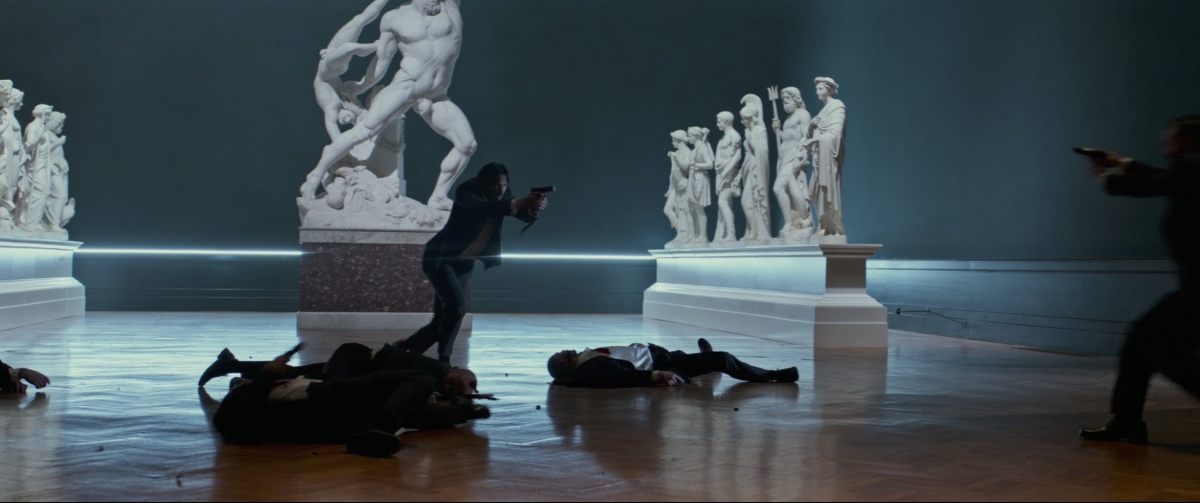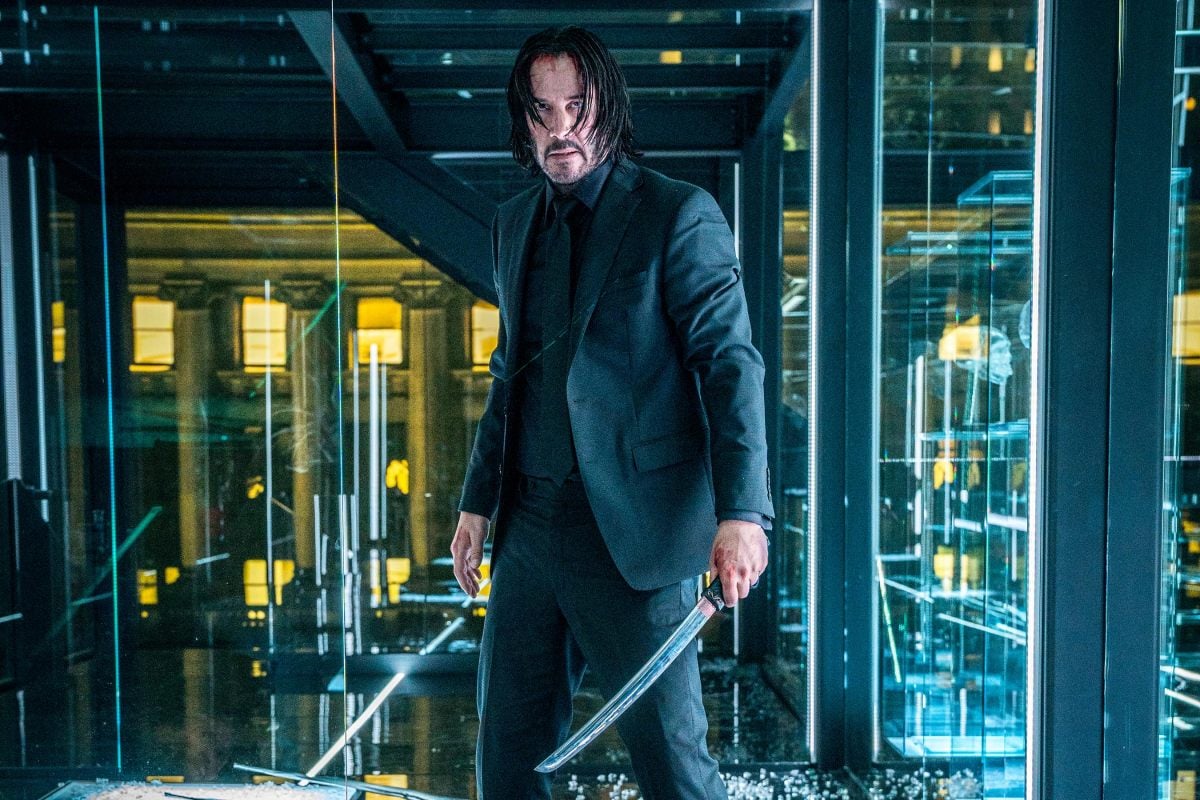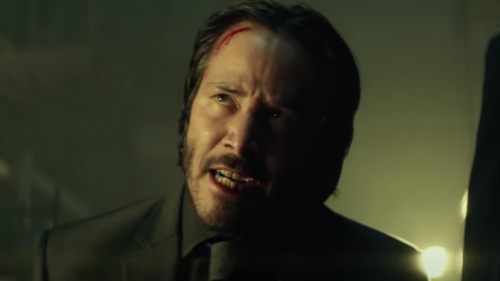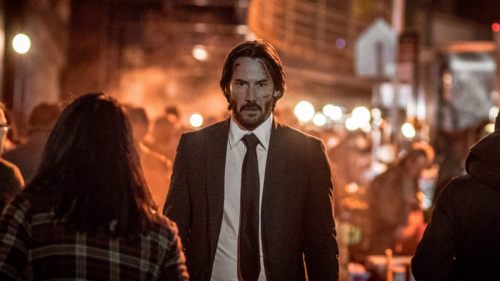The Universe Of John Wick
Note: The following will contain spoilers for John Wick: Chapter 3.
John Wick: Chapter 3 opens with John Wick on the run, hoping to beat the clock before he’s officially excommunicado. He races down an alleyway, through pouring rain and neon-burnished darkness, Dog alongside him. Everyone in New York seems to be an assassin waiting for their chance to kill John Wick. With its cool colors and deep blacks, drama, and heightened reality, the John Wick saga is both chiaroscuro and a comic book, a Caravaggio painting made real. These films blend their literary and cinematic influences with Greco-Roman myth and religious iconography to create a neo-noir pulp fantasy world. Chapter 3 is an international affair, an homage to western and eastern film, art, culture. From characters’ tattoos to classical paintings, every detail in Chad Stahelski’s John Wick: Chapter 3 - Parabellum builds this meticulously-crafted world and tells John Wick’s story: a struggle for one man’s soul that plays out in the underworld, in the realm of the gods, and somewhere in between.
John Wick: Chapter 3 finds John fleeing assassins in the city and across the globe after killing Santino D’Antonio on Continental grounds in Chapter 2. John Wick’s most iconic locale - and the foundation of its world - is the Continental Hotel in New York City. In Chapter 2, we learn there is a network of these hotels, with at least one other location in Rome (run by Franco Nero, the original Django). Chapter 3 expands on this with a third hotel run by Sofia (Halle Berry) in Casablanca, a riff on Rick’s Café Américain. The rule here, of course, is that no blood may be spilled on Continental grounds, a sanctuary for criminals. The concept of “sanctuary” dates back to asylia, the Greek and Roman practice of declaring a religious place “sacred and inviolable,” a refuge from persecution, war, and all acts of violence.
In his book Asylia, Kent J. Rigsby writes: “Many religions, in separating the sacred from the profane, apply this distinction to space; places attributed to the divine are in some measure under the god’s authority, and in them mortals may be bound by rules that do not pertain in secular space. In ancient Greece this boundary was especially strong: as we see in many anecdotes from both life and literature, anyone who entered a temple precinct or clasped an altar or even achieved some other physical connection with sacred space was to be immune from violence, for he had put himself at the discretion of the god rather than of man.” David Morrell’s 1984 novel The Brotherhood of the Rose also features a sanctuary for operatives from intelligence agencies from around the globe, meaning the Continental Hotel has a pulp-fiction precedent. In John Wick’s case, not much has changed since asylum was first established, except that his gods are the High Table.
Visual details have been vital to constructing the John Wick mythos since the very beginning: the Continental, the markers, the coins that evoke Charon’s obol, and tattoos. Just about everyone in this universe seems to have a tattoo, and they each carry history. In Chapter 3, a ballerina’s tattoo reads, “Si vis pacem, para bellum” (If you seek peace, prepare for war), John’s whole deal in this movie. In prison culture, the praying-hands tattoo represents a plea for forgiveness; in John Wick’s world, it also symbolizes fealty. The tattoo reproduces Albrecht Dürer’s pen-and-ink drawing, Study of the Hands of an Apostle, intended by Dürer to be the hands of an apostle kneeling by the Virgin Mary’s tomb, an image of reverence and mourning. The Russian-Orthodox cross conveys John’s past with the Ruska Roma. On one of John Wick’s shoulders, the dog surrounded by flames is Cerberus, the hound who guards the Underworld and ensures the dead don’t escape. On the other shoulder is a snarling wolf, which is a Russian prison tattoo that represents defiance of authority, referred to as an oskal, meaning “grin,” “a baring of teeth towards the system.” As for John’s “Fortis Fortuna Adiuvat” tattoo, it doesn’t translate into the common phrase, “Fortune favors the bold”; it really means something more like: “Fortune will save the strong ones.” In John’s world, strength is valued over boldness. (Iosef Tarasov’s boldness got him killed.)

Coptic Christians require followers to prove their faith with a tattoo of a cross to gain entry into their churches. For an early Christian sect called the Montanists, tattoos identified them as God’s slaves. The tattoo can be a brand, biography, a sign of religious devotion, the mark of a soldier. In John Wick’s universe, they function as all of these things.
These details add texture and heighten mood, but more significantly, they tell us about John. Before John’s excommunicado goes into effect, he visits the New York Public Library, where he requests Alexander Afanasyev’s Russian Fairy Tales. His belongings - a marker, coins, a crucifix, and a photograph of him and his wife - are hidden in the book, behind Ivan Bilibin’s illustration of Vasilisa the Beautiful at the hut of Baba Yaga. Vasilisa’s story is a lot like Cinderella’s - and John Wick’s. Her mother dies, leaving her with her father and stepfamily who mistreat her. Before her death, Vasilisa’s mother gave her a magical doll, who now helps her with her chores. Vasilisa goes to Baba Yaga’s hut because the light has gone out in her family’s home. Baba Yaga agrees to give Vasilisa fire if she completes several impossible tasks, which Vasilisa completes (with an assist from the doll). The illustration depicts Vasilisa after she’s escaped Baba Yaga, with a skull full of the fire she was promised. Details of John’s story are contained within Vasilisa’s story: obviously the Baba Yaga connection, but they also share a terrible loss that prompts a journey where impossible tasks must be completed. Like Buster Keaton at the beginning of Chapter 2 and Chapter 3, the inclusion of this book and this illustration sets the film’s tone, but it also telegraphs the fact that John Wick’s life is its own kind of folktale, a fable about fate, karma, and grief.
In Chapter 2 and Chapter 3, classical art becomes essential. When John Wick is desperate to escape New York, he meets with Anjelica Huston’s the Director (a character Stahelski likened to Oliver Twist’s Fagin for assassins), who took in Belarusian orphan Jardani Jovanovic and turned him into a professional hitman. Every painting in her office at the Tarkovsky Theater feels like a self-contained film that complements John’s tale. The most prominent is Caravaggio’s Judith Beheading Holofernes, which hangs behind John Wick during their conversation.
Holofernes was an invading Assyrian general, an enemy of Israel, and Judith was Holofernes’ assassin, divinely appointed, a widow who seduced him and got him drunk, only to lop off his head with his own sword. In Caravaggio’s painting, Judith, her maidservant, and Holofernes are dramatically lit, spotlighted like actors on a stage. The painting itself feels like an action scene, grisly, intense, and involving; most paintings portraying Judith show her with the head after the fact, but Caravaggio portrays her in the act. Caravaggio’s work is cinematic, and it feels like a forerunner of film. On the floor behind John is another painting, mostly hidden from our view, which also renders Judith’s story: Artemisia Gentileschi’s Judith and Her Maidservant with the Head of Holofernes, her masterpiece, inspired by Caravaggio. At age 17, Gentileschi was assaulted by the artist Agostino Tassi, and she tried to attack him with a knife. Gentileschi identified with Judith, and her paintings of Judith beheading Holofernes feel like they tell Gentileschi’s own revenge story.
The first version of Caravaggio’s The Conversion of Saint Paul hangs behind the Director. Saul was on his way to Damascus to prosecute Christians when he heard the voice of Christ asking him why he persecuted him. After Saul’s encounter with Christ, he stopped killing Christians, converted, and became St. Paul. On the floor below The Conversion of Saint Paul is Rembrandt’s Sacrifice of Isaac: God had ordered Abraham to sacrifice his son Isaac, but just as Abraham is about to kill his own child, an angel grabbed his wrist to stop him. Like Holofernes, Rembrandt’s painting is dramatic, cinematic. In most depictions, Abraham still holds the knife, but Rembrandt chooses to show the knife in midair as it’s falling from Abraham’s hand.
The painting next to Sacrifice of Isaac is Léon Cogniet’s Massacre of the Innocents, which shows the aftermath of Herod the Great’s order for all boys age 2 and under to be killed. It wasn’t just Herod’s whim - it was an Old Testament prophecy. The painting focuses on one mother holding her child as they hide from Herod’s army. In the background, an assassin pursues another mother running with her two children. The Biblical stories depicted in these paintings all concern assassins at the mercy of God, whether their killings and violence are forbidden by God, prophesied, or outright ordered by the divine. These are moments when the divine interrupts the lives of mortals, and mortals obey, just like John Wick, who is ruled by the High Table and at their mercy.
Art reveals John’s struggle beginning in Chapter 2. Gaetano Cellini’s sculpture L’umanità contro il male (Humanity Against Evil) is shown in the museum where John meets and hunts Santino. At its base, Cellini inscribed the title of his work and the lines: “Thus I’ll extirpate using my teeth and nails / the eternal pain that stings my heart.” The sculpture is an allegory of the eternal struggle against evil in the world, and in ourselves. And it’s a perfect metaphor for John’s battle against the forces that beset him, outwardly and from within.

At the beginning and the end of Chapter 2, John shares the frame with a statue of Hercules (above). It is Antonio Canova’s Ercole e Lica (Hercules and Lichas), which depicts Hercules just before his death, when he hurls his servant Lichas into the sea because he believes Lichas betrayed him by bringing him a poisoned shirt. (Spoilers: Lichas was innocent, another victim of a centaur’s scheme to kill Hercules.) The statue is flanked on either side by the pantheon of twelve Olympians, like the twelve members of the High Table.
John Wick is a mythic figure in the Greco-Roman tradition. The first John Wick is a retelling of the myth of Orpheus and Eurydice. Hades gives Orpheus the chance to rescue his wife, only to lose her at the last moment because he makes the mistake of looking behind him. John’s tale segues into Dante’s Inferno: John is doomed to journey through nine circles of hell alone, beset by people who drag him further into the depths. His only reasons to live are the memory of his wife, and the distant dream that he might one day be able to escape hell and return to the world he knew when they were together. He’s Odysseus, a man who just wants to return home. He’s Achilles, a man enraged by an unjust death who slaughters many men on his way to kill the one who committed the crime, who even takes on one of the gods. And in Chapter 2, John is Hercules.
Hera caused Hercules to go temporarily mad, killing his children and wife. Though John isn’t responsible for his wife’s death in the way that Hercules is, both are driven by grief and rage. Hercules sought to be redeemed for what he’d done. His cousin, King Eurystheus, conceived of the Twelve Labors for Hercules to perform to make amends - not unlike the “impossible task” that Viggo Tarasov gave John Wick so he could retire. John’s “Labor” in Chapter 2 is to kill a member of the High Table. Once Hercules and John completed these tasks, they expected to live in peace.
By Chapter 3, Wick is Hercules going to war against the gods. After Hercules executed his Twelve Labors, Hera struck again, and Hercules, in his second Hera-induced madness, killed a prince, mirroring John’s assassination of Santino. Like the Elder (Saïd Taghmaoui) instructing John that he must serve, the Oracle of Delphi told Hercules he must become a slave to atone. Hera prophesied that the Giants would one day rebel, overthrowing Zeus and freeing the Titans, and only a mortal could save the Olympians. Hercules fought alongside the Olympians against the Giants. All three chapters of John’s story portend war: with characters named Helen (like Helen of Troy), Ruby Rose’s Ares, the statues of Roman war gods Bellona and Mars in the Continental Hotel, the paintings The Battle of Custoza and The Battle at Dogali featured in Chapter 2. Hercules’ journey parallels John’s, a man forced to complete impossible tasks, who serves the gods of the High Table, his life determined by their whims and inscrutable motives.
Like a Greco-Roman figure, John is constantly forced through labyrinths, both metaphoric and real. In Natural History, Pliny described the Cretan labyrinth’s “circuitous passages, windings and inextricable galleries which lead to and fro.” He wrote, “We must picture to ourselves a building filled with numerous doors, and galleries which continually mislead the visitor, bringing him back, after all his wanderings, to the spot from which he first set out.” John has been thinkin’ he’s back since the first movie, and other characters keep pointing out his return to the fold. The Director comments: “Somehow you managed to get out. But here you are, back where you began,” and the Elder tells John: “My son, how have you come to be so lost? You think I speak of your location? I’ve never seen a man fight so hard to end up back where he started.” No matter how hard John Wick tries to escape his past, he always returns to the place where he started, stuck in a labyrinth of his own making.
John finds himself in literal labyrinths as well: the catacombs of Rome and the Reflections of the Soul exhibit in Chapter 2, and in the Continental’s glass house in Chapter 3. Production designer Kevin Kavanaugh explained the two-story “manager’s office”: “The concept was to create a space where everything is exposed, a place where there are no secrets.” Inside this house, John feels vulnerable, observed by his enemies, like an animal trapped behind glass. On the first floor, there are glass skulls and relics enclosed in glass cases, each representing a “fallen assassin.” (Another assassin honored in the Continental: at the center of Winston’s circle of guns is a replica of the weapon that John Wilkes Booth used to kill Abraham Lincoln.) And on the second floor: a chess game, a globe, and samurai armor. Climbing the steps from the first floor to the second floor suggests an ascension or an evolution, the individual assassins contrasting with the samurai who served something greater.

John Wick and Mark Dacascos’s Zero stand on either side of a samurai costume, both men’s reflections visible in the glass. Zero is a killer for hire, who asks no questions when the Adjudicator (Asia Kate Dillon) asks him to serve. Zero says, “See? We’re the same.” According to Zero, they are both masters of death. John disagrees. These samurai costumes that surround him seem to ask John, “Who do you serve?” Will John serve the High Table, and continue to be a master of death, or will he rebel, staying true to the man he became when he met his wife and retired? This is John Wick’s duality: the man and the myth, human and superhuman. And this duality is represented by reflections, a recurring motif in all three John Wick films. Chad Stahelski said, “If you look in John Wick, I think we did something like 39 scenes with reflections. Every scene opens with a reflection, whether it’s in a mirror or in a puddle.” John is always looking at two selves.
All the mirrors and reflective surfaces in the John Wick films evoke the use of mirrors in Shinto temples. In Shintoism, the mirror represents kami, a complex, ambiguous Japanese word basically meaning spirit, divinity, god. https://www.bbc.co.uk/religion/religions/shinto/beliefs/kami_1.shtml Inazo Nitobe wrote in Code of the Samurai: “The presence of [the mirror in Shinto temples] is easy to explain: it typifies the human heart, which, when perfectly placid and clear, reflects the very image of the Deity. When you stand, therefore, in front of the shrine to worship, you see your own image reflected on its shining surface, and the act of worship is tantamount to the old Delphic injunction, ‘Know Thyself.’” Nitobe explains that this knowledge was, “of a moral kind, the introspection of our moral nature.” John confronts himself and his duality in these reflections.
Like samurai and knights, Wick and the assassins of this world are a warrior class in a vast, secret feudal system, with the High Table - and the Elder - at the top of its hierarchy. The High Table is mysterious, like the Round Table of Arthurian legend, and their motives are abstruse, like those of the Olympian Gods. They are obsessed with fealty, penance, consequences, rules, and a code of honor not unlike bushidō. The Elder sits above the High Table, determining this system’s rules and moral structure. He forces John to choose which he’ll be - the man or the myth. John must sacrifice his humanity and his past, this last piece of himself, when he gives the Elder his wedding ring, a more shocking offering than his own finger. John Wick is prepared to devote himself fully to the High Table if it means he can live to remember Helen. That vow is empty, however - John doesn’t want to serve, nor has he ever worshipped anything or anyone besides his wife.
The end of Chapter 3 positions John as a kind of reluctant revolutionary, forming an alliance with Laurence Fishburne’s Bowery King (who feels like another cinematic revolutionary: Cyrus from The Warriors) and fomenting an uprising. This full-blown revolt against the High Table feels like class war and a religious movement. Considering Winston likens John to a priest in Chapter 2, it’s not so far-fetched to compare John Wick to Martin Luther rebelling against the church. John Wick is also Satan defying God in Paradise Lost, and Hercules taking on the Giants. He breaks the rules and takes a wrecking ball to the status quo.
Though John Wick is like a Greco-Roman figure, he’s not exactly heroic. Our protagonist is a sympathetic villain, and he’s embarked on whatever the opposite of the hero’s journey is. And the stakes are more than just his life - his soul is in play, and it doesn’t look good for him. John Wick is best described as a Byronic hero: world-weary and melancholic, self-destructive, anti-establishment, cunning, ruthless, an outlaw and an exile and a wanderer. He has no traditional heroic virtues except for a strong sense of honor. Historian Thomas Macaulay responded to the advent of the Byronic hero by describing him as, “a man proud, moody, cynical, with defiance on his brow, and misery in his heart, a scorner of his kind, implacable in revenge, yet capable of deep and strong affection.” He could’ve been describing John Wick.
In his book The Byronic Hero: Types and Prototypes, Peter Thorslev explains that the Byronic hero represents, “a rebellion which asserted the independence of the individual and the primacy of his values not only in the face of society, but even in the face of God.” These noble outlaws are tragic figures, who either go down, “in glorious defeat, cursing God and dying, or they commit their lives to transforming the world.” At this point, John Wick seems to be on a path toward glorious defeat, but we hope the latter is his ultimate fate.
The Elder tells John he can reverse the excommunicado, but John will be bound to the High Table for the rest of his days, and the cost of his life will be Winston’s death. John agrees initially, but he reconsiders when Winston asks: “The real question is, who do you wish to die as? The Baba Yaga? The last thing many men ever see? Or as a man, who loved and was loved by his wife? Who do you wish to die as, Jonathan?” Winston sums up John’s fundamental conflict. John Wick was once a samurai who served death, then a man who loved his wife. Now he’s ronin, questioning his allegiance. He hopes to be redeemed, but he just can’t stop killing people.
The marquee at the Tarkovsky Theater reads Tale of Two Wolves. In this story, a grandfather tells his grandson that there are two wolves at war inside everyone, one good and one evil. The grandson asks which wolf wins, and the grandfather responds: “The one you choose to feed.” At the heart of John Wick’s tale is a man just trying to choose which wolf to feed.



